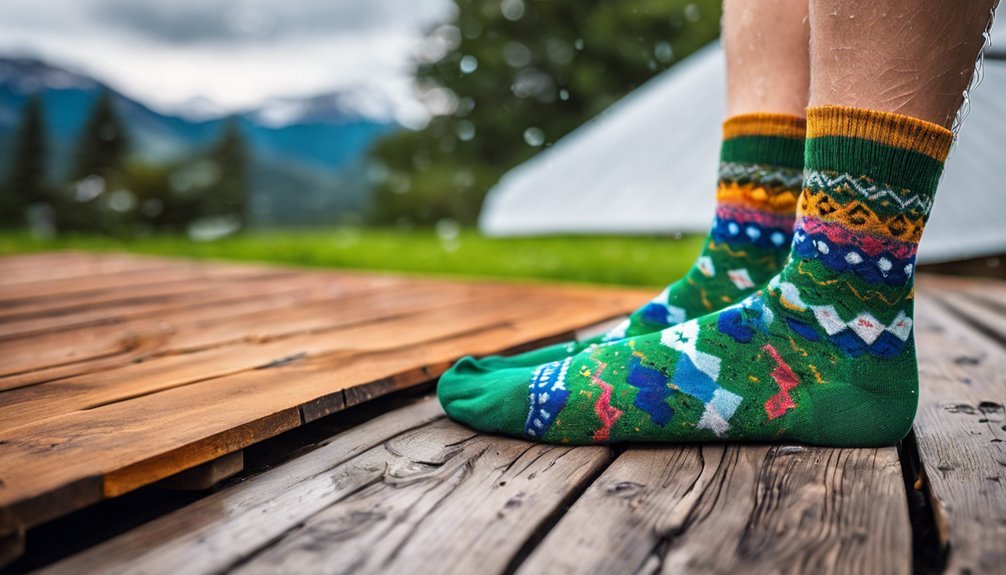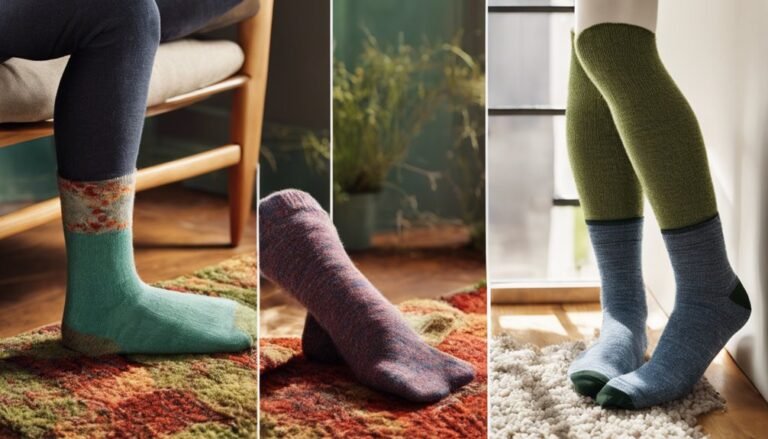How Socks Impact Foot Sweat in Different Climates
Socks greatly impact foot sweat based on climate. In humid conditions, moisture-wicking materials are essential to keep feet dry and prevent discomfort. Cotton, while breathable, can retain moisture, making it less ideal for warmth. Wool offers excellent insulation and moisture management in cooler climates, while synthetic fabrics excel in varied environments with their performance features. Considering factors like sock thickness and design can enhance sweat management. Explore further to uncover tips for choosing the best socks for your needs.
Understanding Foot Sweat: Causes and Effects
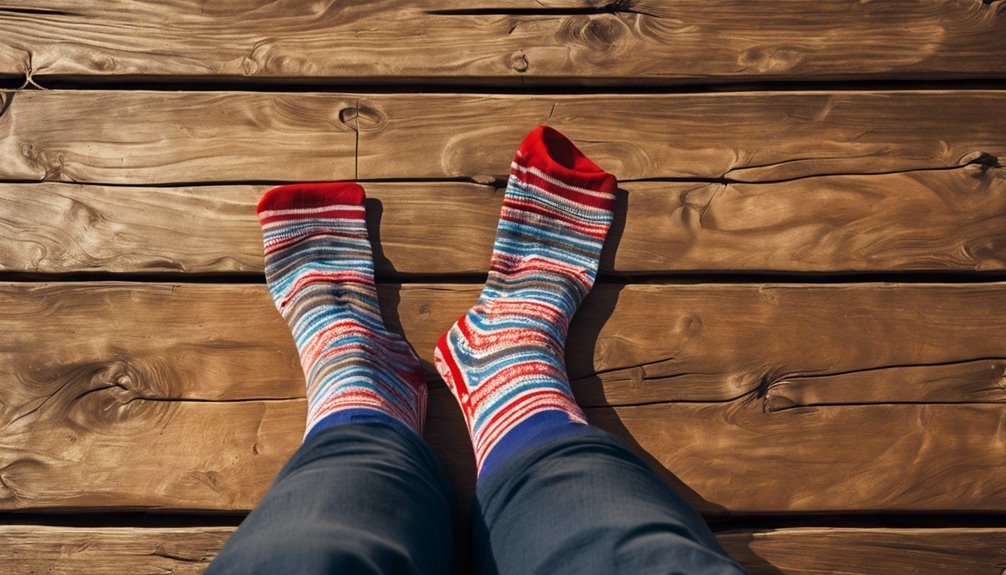
While you may not think about it often, foot sweat is a common issue influenced by various factors, from genetics to environmental conditions. Your sweat glands play an essential role in regulating body temperature, but when they become overactive on your feet, it can lead to discomfort and skin health issues. Factors like hormonal changes, stress, and footwear choices can exacerbate foot sweat. This excessive moisture creates a breeding ground for bacteria, leading to unpleasant odors and potential fungal infections. Maintaining proper skin health is important; opting for moisture-wicking socks and breathable shoes can help manage sweat. Understanding these causes and effects empowers you to take control of your foot health and enjoy the freedom of comfortable, dry feet.
The Role of Climate in Foot Sweat
Climate considerably influences foot sweat, impacting how much moisture your feet produce. In humid conditions, the air's saturated with moisture, forcing your body to ramp up sweat levels to cool down. Conversely, in arid climates, your feet may sweat less as the air absorbs moisture quickly, but that doesn't mean you're free from sweat altogether. The climate effects on foot sweat vary dramatically; if you live in a hot and dry area, you might notice your feet still getting clammy due to the contrast between heat and low humidity. Understanding these dynamics helps you choose the right socks, ensuring they meet your needs regardless of climate. This knowledge empowers you to maintain comfort and freedom in any environment.
Sock Materials: Breathability vs. Insulation
When choosing socks, you've got to take into account the balance between breathability and insulation. Moisture-wicking fabrics are essential for keeping your feet dry, but in colder conditions, thermal insulation properties play a vital role. Understanding these materials can help you select the right socks for any environment.
Moisture-Wicking Fabrics
Choosing the right sock material can considerably impact your comfort and foot health, especially if you're prone to foot sweat. Moisture-wicking fabrics utilize advanced fabric technology to enhance moisture management and keep your feet dry. Here's what to look for:
- Synthetic Fibers: Materials like polyester and nylon excel at pulling moisture away from your skin.
- Natural Blends: Merino wool offers natural moisture-wicking properties while regulating temperature.
- Mesh Panels: Integrated ventilation zones enhance breathability, ensuring airflow.
Thermal Insulation Properties
Understanding the thermal insulation properties of sock materials is vital for maintaining comfort in varying temperatures. The balance between breathability and insulation can greatly affect your foot's microclimate. Materials with low thermal conductivity, like wool, create effective insulation layers that trap warmth without sacrificing breathability. This is essential in colder environments, as it helps regulate foot temperature and moisture. Conversely, lightweight synthetic materials excel in warmer climates, offering breathability while compromising on insulation. When choosing socks, consider how these properties align with your activities and the climate. High-performance socks should provide the right insulation layers to keep your feet comfortable, ensuring you can enjoy your freedom and stay active in any setting.
Cotton Socks: Pros and Cons in Humid Conditions
When it comes to humid conditions, cotton socks offer notable breathability and moisture absorption, helping to keep your feet comfortable. However, you should consider their durability, as prolonged exposure to humidity can lead to quicker wear and tear. Balancing these factors is essential in choosing the right sock for your needs.
Breathability and Moisture Absorption
Although cotton socks are often favored for their comfort, their performance in humid conditions can be a mixed bag due to their breathability and moisture absorption properties. While they can offer some benefits, you might find the following issues arise:
- Moisture Retention: Cotton absorbs sweat but doesn't wick it away, leading to soggy socks.
- Temperature Regulation: In high humidity, cotton may fail to keep your feet cool, impacting comfort.
- Limited Sweat Reduction: The inability to effectively disperse moisture can lead to an uncomfortable, damp environment.
In humid conditions, while cotton feels soft, it might not deliver the desired sweat reduction and temperature regulation. For ideal foot comfort, consider alternatives designed specifically for high humidity.
Durability in Humidity
While cotton socks may seem like a comfortable choice for humid conditions, their durability can be compromised by excessive moisture. Cotton absorbs sweat, which may lead to a damp environment that accelerates wear and tear. In humid climates, this lack of humidity resistance undermines sock longevity, causing them to fray or develop odors more quickly. While you might appreciate cotton's softness, you'll find that synthetic materials often outperform regarding durability and moisture management. If you prefer the feel of cotton, be prepared for more frequent replacements. Ultimately, understanding these trade-offs can help you make informed choices about your sock selection, ensuring comfort without sacrificing longevity in the face of humidity.
Wool Socks: Warmth and Moisture Management
As temperatures drop and conditions grow damp, the choice of socks becomes essential for comfort and performance. Wool socks stand out due to their unique wool properties, which offer both warmth and moisture retention. When considering wool socks, keep these benefits in mind:
- Insulation: Wool fibers trap air, providing warmth without bulk.
- Moisture Management: Wool can absorb up to 30% of its weight in moisture, keeping your feet dry and comfortable.
- Odor Resistance: Natural lanolin in wool helps reduce odors, even after prolonged wear.
With these advantages, wool socks become an ideal choice for colder, damp climates, ensuring your feet stay warm, dry, and free to move. Embrace the freedom of adventure, knowing your feet are well-protected.
Synthetic Socks: Performance in Varied Environments
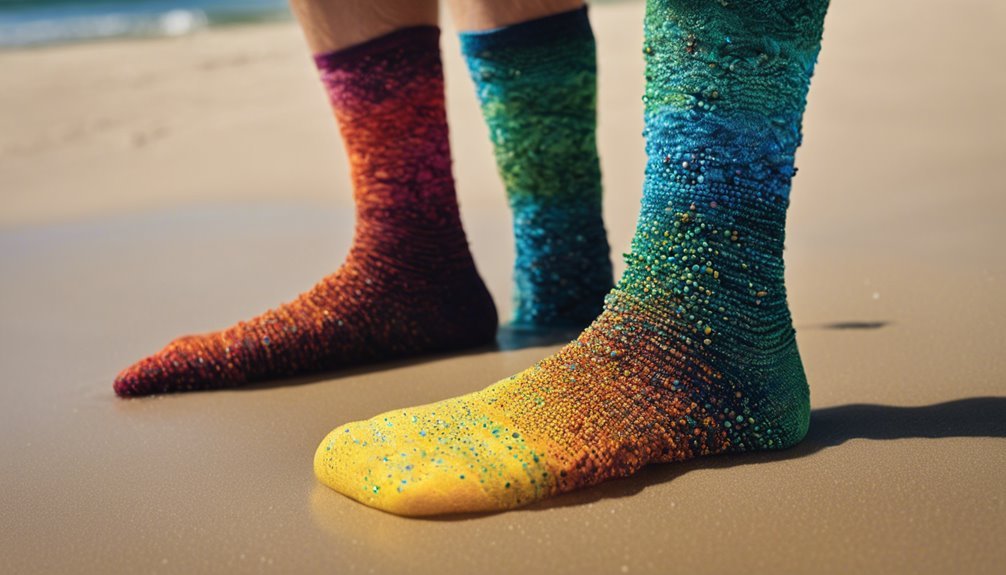
Wool socks excel in cold, damp conditions, but synthetic socks offer distinct advantages in diverse environments. These socks, made from synthetic fibers, provide exceptional moisture control, making them ideal for active lifestyles in warmer climates. They wick away sweat quickly, preventing the buildup of moisture that can lead to discomfort and odor.
| Environment | Advantage of Synthetic Socks |
|---|---|
| Hot and humid | Excellent moisture management |
| Cold and dry | Lightweight and insulating |
| Wet conditions | Quick-drying capabilities |
| High activity | Breathable and flexible |
| Everyday use | Durable and easy to clean |
In essence, synthetic socks enhance comfort and performance, allowing you the freedom to explore various environments without the worry of excessive foot sweat.
Sock Thickness and Its Impact on Comfort
Choosing the right sock thickness can greatly influence your overall comfort, especially during prolonged wear. Different thicknesses cater to various activities and environments, affecting your comfort levels considerably. Consider these factors when selecting your socks:
- Padding: Thicker socks provide more cushioning, ideal for long walks or hikes, while thinner socks offer less bulk for casual wear.
- Breathability: Thinner socks often enhance airflow, reducing sweat and keeping your feet cool, particularly in warmer climates.
- Fit: A snug fit from appropriate sock thickness prevents blisters and discomfort, ensuring you can move freely without distractions.
Ultimately, understanding sock thickness helps you maintain ideal comfort levels throughout your day, empowering you to choose the perfect pair for any occasion.
The Importance of Sock Design for Sweat Management
While you might not think about it often, the design of your socks plays an essential role in managing foot sweat. The sock structure, including materials and weave patterns, directly influences sweat dispersion. Opting for breathable fabrics like merino wool or synthetic blends allows moisture to escape rather than accumulate, keeping your feet drier and more comfortable. Well-designed socks feature strategic ventilation zones that enhance airflow, vital in warmer climates where sweat increases. Additionally, moisture-wicking properties help to pull sweat away from your skin, reducing the risk of blisters and odor. By prioritizing thoughtful sock design, you can markedly improve your foot health and overall comfort, allowing you to move freely without the distraction of damp socks.
Tips for Choosing the Right Socks for Your Climate
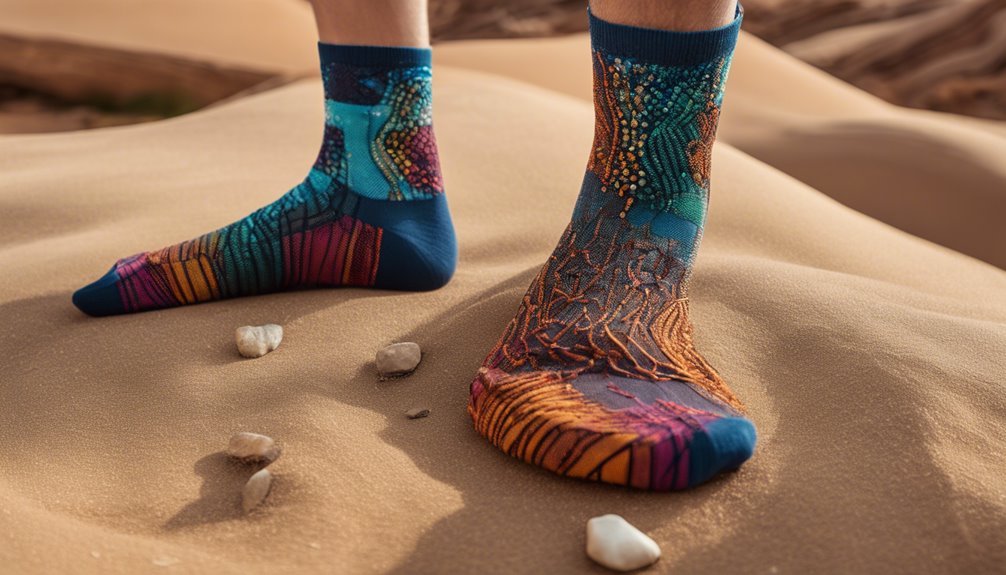
When selecting socks for your specific climate, it's crucial to take into account both the temperature and humidity levels you'll be facing. Choosing the right sock style can greatly affect your comfort and sweat management. Here are three tips to guide your selection:
- Material Matters: Opt for moisture-wicking fabrics in humid climates, while breathable wool is great for cooler, drier conditions.
- Sock Style: Consider ankle vs. crew lengths based on your activities and footwear. Shorter styles may suit warmer days, while longer options provide warmth in colder weather.
- Color Choices: Darker colors might hide stains better in wet climates, while lighter shades reflect sunlight, keeping your feet cooler.
With these guidelines, you can make sure your sock choices align perfectly with your climate.
Frequently Asked Questions
Can Foot Sweat Lead to Fungal Infections?
Yes, foot sweat can lead to fungal infections. Excess moisture retention creates an environment for fungal growth. Keeping your feet dry and choosing breathable footwear can greatly reduce the risk of developing such infections.
How Often Should I Change My Socks?
You should change your socks daily to maintain sock hygiene and promote moisture management. This practice helps prevent odor and fungal infections, ensuring your feet stay fresh and comfortable, allowing you to enjoy your activities freely.
Do Certain Colors of Socks Affect Sweat Absorption?
Studies show that around 70% of people prefer specific sock colors for their mood. While sock material plays an essential role in sweat absorption, color psychology can subtly influence your comfort and perceived freshness throughout the day.
Are There Specific Sock Brands Recommended for Sweaty Feet?
When choosing socks for sweaty feet, look for brands utilizing moisture-wicking technologies and breathable sock materials. These features help keep your feet dry and comfortable, allowing you to move freely without the discomfort of excessive moisture.
Can Foot Sweat Cause Shoe Damage Over Time?
You might not realize it, but foot sweat can be a silent saboteur. Over time, moisture retention can lead to shoe hygiene issues, causing materials to break down and your favorite kicks to lose their luster.

